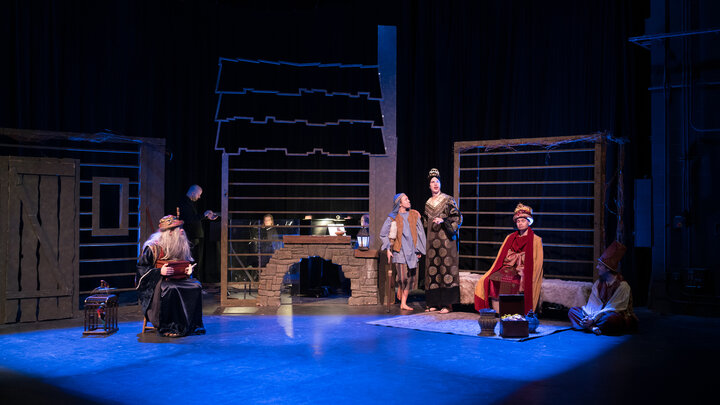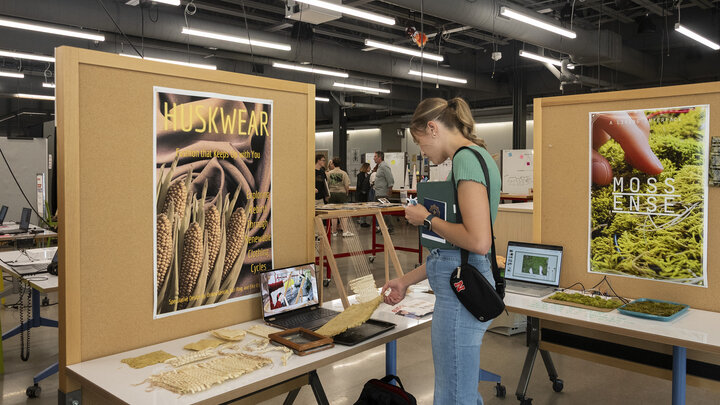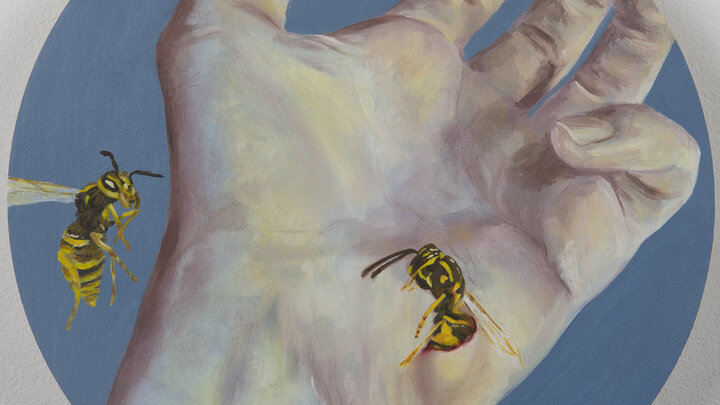Lincoln, Neb.--Three emerging media arts seniors will travel to New York City to compete in the Biodesign Challenge Summit June 12-13 at the Museum of Modern Art and Parsons School of Design.
Annette Foreman, Owen Strazdas and Noah Trumble will be competing with their project titled Mossense. They were selected from five project teams in a class led by Assistant Professor of Emerging Media Arts Ash Eliza Smith.
“Mossense is a speculative interface that uses engineered moss to create a touch-sensitive surface—essentially a living interface that responds to human contact through scent or color change,” said Trumble, a senior emerging media arts major from Lincoln. “Annette, Owen, and I came up with it while exploring how nature could replace digital hardware in future technologies. Our project aimed to reduce reliance on non-biodegradable materials by proposing an organic, responsive surface, addressing sustainability through biomaterial innovation, trying to see how to get people regrounded to our natural world in subtle ways, and electronics waste reduction.”
Foreman, a senior emerging media arts major from Lincoln, said they went through several different phases of development before narrowing their scope into developing nature textured interfaces.
“Moss was chosen as a material due to its resilience, short length and softness,” she said. “Our results were positive, first trying out our system with synthetic moss and eventually working towards using real moss after accounting for the dirt, which was previously negating the reception of the touch sensors. On an immediate level, we wanted to create more physical connectivity with modern interfaces, but as an additional effect, air would also be purified.”
A multidisciplinary team of faculty judges, including Assistant Professor of Interior Design Kendra Ordia, Associate Professor of Mathematics Adam Larios and Associate Professor of Graphic Design Aaron Sutherlen, judged the projects and selected the team to represent the University of Nebraska–Lincoln at the summit in New York.
The Biodesign Challenge is an interdisciplinary education program and competition that works with students to create projects that bridge art, design and biotechnology. The goal of the program is to prepare young artists and designers to work with emerging biotech and to build collaborations between artists, designers and biologists and to engage the public with visions for future applications of biotechnology.
Sixty-five schools from 24 countries developed biodesign projects this year to address major issues in sustainability using biotechnology. At the Biodesign Challenge Summit in June, these teams, including Mossense, will present their projects before a live audience, contributing solutions to areas as diverse as agriculture, fashion and biosecurity. On the final day of the Summit at the Museum of Modern Art, finalist teams will go head-to-head for special prizes that will help kickstart their ideas.
“It’s surreal and such an honor,” said Trumble of being chosen to represent UNL in New York. “We put a lot of heart into Mossense and were very proud by how smoothly the project came to us. I’m most excited for our project to connect with other students and experts working at the edge of biology and design. When we found out we were selected, we were shocked. We thought several other teams were just as strong if not more, so it really meant a lot.”
Foreman said she is nervous about presenting their work in New York.
“But I feel more confident knowing I will have the support of the faculty and other students on my side,” she said. “Going out of one’s comfort zone on occasion is a way to grow, and I’m hoping through this process I will improve my presentation skills and confidence. I am also interested in learning from the other entries’ presentations.”
Trumble said working on this project has helped him grow.
“It’s helped me grow in how I think about design—less about creating objects and more about designing systems, materials and relationships with nature,” he said. “It’s also been a huge confidence boost in collaborative and interdisciplinary work.”
Trumble said working with living materials changed his mindset.
“It forces you to consider care, time and interaction differently,” he said. “I think that shift is really valuable, especially in the context of climate and sustainability.”



